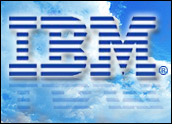
It took about an hour before I finally switched from thinking that my initial experiences with Second Life were a waste of time, to actually finding them being productive in new ways.
I was one of a 3D flurry of invited “VIPs” to enter an IBM pavilion inside Second Life. With my unique personage avatar seated (it took me five minutes to figure out how to sit down) in the front row, I read a chat sequence as IBM executives (some virtually knee-deep in the stage) told of how we’re at the beginning of something big — and Blue.
Increased Comfort Level
There was applause and some whistling. And there were some instant messaging conversations in the audience about what they had “seen” on the stage. It was not much different from the thousand other industry events I’ve attended since 1988 (once I was able to sit down). And this was all from my home office (and I was intermittently doing some other useful online stuff too, like e-mail and calendar).
What was different is that I was a virtual arm’s length from some heavy-hitting IBM talent and leadership, and I was able to communicate with them, and learn from them quite well. That is not always the case in the real world, where crowds, noise, location, and the competition can get in the way.
There is an egalitarian equalizing effect when your avatar IMs with another — even if you know who they are. There’s a comfort level with being virtual, and the IBMers seemed eager to chat with lots of folks. I can see getting better access to executives and the creative minds at IBM in Second Life than I do in real life, and that’s a good thing.
I expect that IBM customers, partners, and just the nerdy curious may find the same thing. That means that Second Life, like a lot of things on the Internet, scales down as well and perhaps more powerfully than it scales up.
So Close, Yet So Far
Second Life could be a best-yet example of the long tail of digital personal communications and collaboration. Having a physical distance while being virtually close can allow high-level people to get out of the box and “shake” more hands in the crowd. With a click, they are back at their desks and can opt in or out of any conversation as they wish — no hard feelings.
As the head of Sun Microsystems’ research lab, Bob Sproull, recently told me: “We’re all still looking for the killer collaboration application.” And as he and Sun are also well aware, Second Life is getting closer.
One reason for this is that Second Life and its ilk form a great way to let otherwise hard-to-reach people become accessible, with terms amenable to all. And that, my friends, is a business benefit — a big one.
In many business activities, access is everything. Using such virtual environments, a company’s best minds and communicators can reach far more people directly, rather than sitting in airports or viewed only remotely from a far-off podium. This is a killer application of evangelism, sales, and implementation support — and you never leave home.
Technology at Your Fingertips
At the IBM event, we were then all invited to transport (you know it when you do it) to a series of other IBM simulated environments where there are resources for exploring virtual e-business activities (a virtual travel agency, for example) and a very cool SOA education destination.
You can watch a video trailer on what SOA is and why it’s valuable (these also can be seen on YouTube if you search on “SOA” there). There is an SOA cafe, a room that touts the merits of reuse, and a place to gather and chat on SOA stuff. IBM also has its own teleport “sculpture,” to help get to and fro with ease amid these resources.
So what? Some of you are no doubt thinking. So did I until it occurred to me that by perceiving that I’m at an IBM SOA fairground, I lost track of the fact that I’m also a mere blur of electrons away from the actual underlying technology being discussed. If you’re at the SOA counter and you want to know about a bill-to-order service, grab it, use it and put it through the paces instantly. Buy it, if you like; a free trial perhaps?
Unlike in the temporal world, like at a trade show, the technology is always far away and abstract from the crowds, stages, hallways and discussions. Sure, it’s people-centric at trade shows, but the technology is too often missing from the party. (How many times have you been shown a server software product loaded on a laptop in a hallway? Talk about virtual.)
Part of the Process
By leaving the temporal world and amusing ourselves into attending a fake tradeshow via Second Life, we can virtually interact with the technology better — we are actually in the realm of the technology itself, where all the attributes and capabilities of the technology is instantly available. What better place to learn about server-centric services than in the technology itself, chatting with the people who built it? We don’t just talk about SOA, we are in SOA.
We don’t just watch a slide deck or a video, we teleport to where the developers and architects are reviewing the next set of requirements. We add in our wishes — and are heard. It’s not just open source, it’s open use of services before we need to commit or buy — without leaving our seats.
While you do give up some of the human experience to enter the Second Life technology realm, you still remain in sufficient human-scale, and with rich communications so that being embedded in the technology becomes the real value. It opens entirely new ways to learn, test, use, amend, and exploit the technology. After all, you are in the matrix. The ones and zeros are just below the surface, not an abstraction but a part of the experience.
I therefore see Second Life as IBM does, a powerful tool for bringing people and technology together, and given that proximity, able to productively accelerate the processes that bind them. Yes, SOA may actually make more sense in the virtual world than it does in the real world, where the effects of SOA benefits will ultimately best manifest themselves. Evangelizing SOA in this way should form an important part of getting the story out.
Dana Gardner is president and principal analyst at Interarbor Solutions, which tracks trends, delivers forecasts, and interprets the competitive landscape of enterprise applications and software infrastructure markets for clients.



















































Social Media
See all Social Media